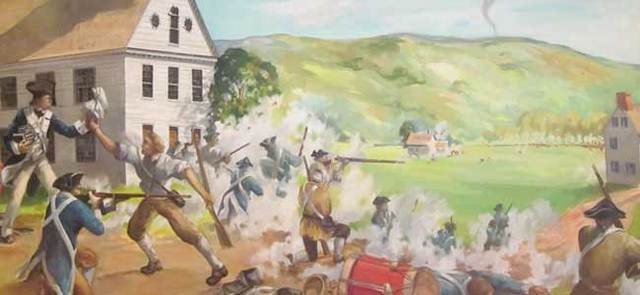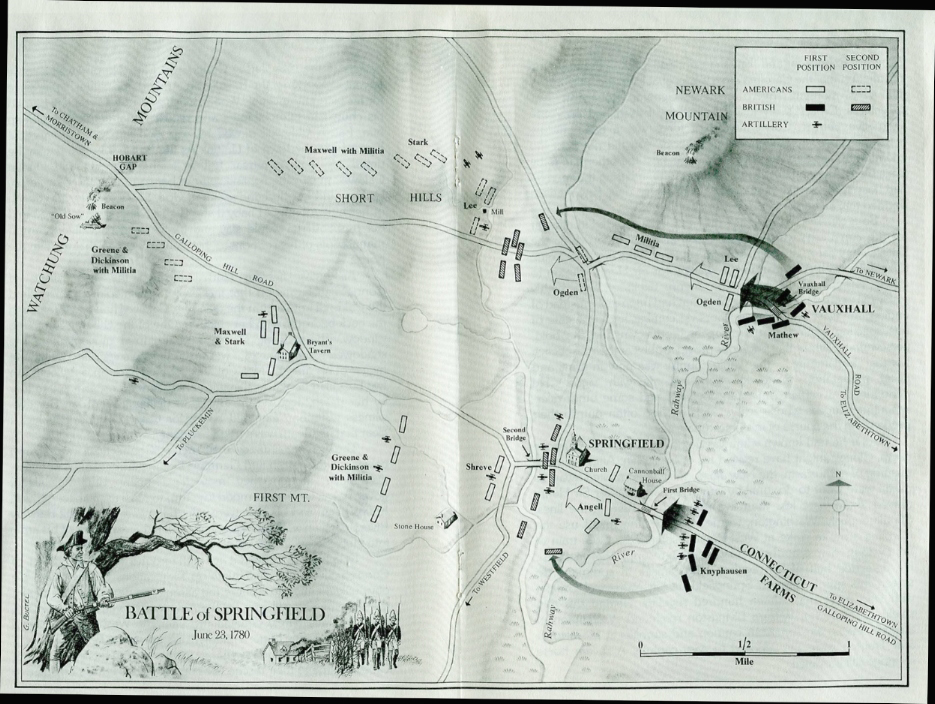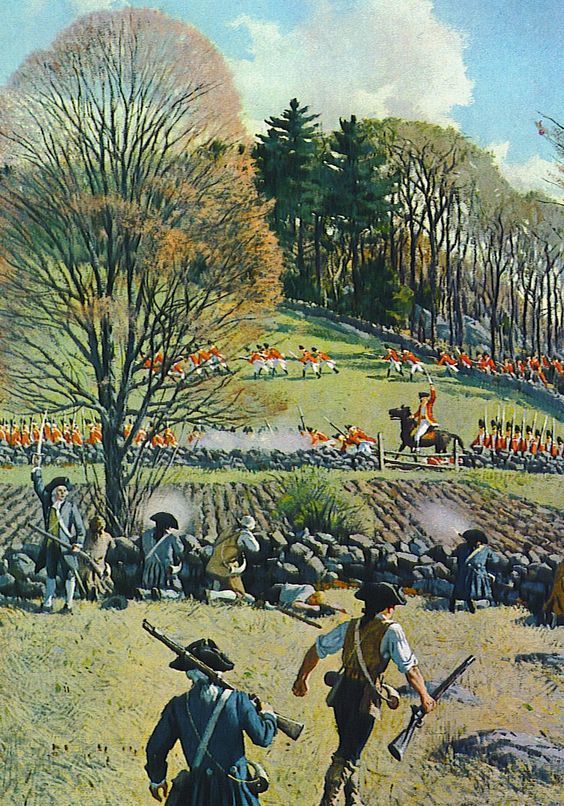Everyday life was interrupted by skirmishes and battles between British and Colonial troops fighting for independence from England. New Jersey was a key battleground of the American Revolution, with more major battles fought here than in any other colony. The countryside was ravaged, as both British and Colonial troops sought food for their men and horses. The daily lives of Elizabethtown residents were filled with anguish.
The population was divided on the issues of the conflict. In some cases, men within a single family fought against each other, and neighbor fought against neighbor. Driven by a desire for freedom, many men left their farms and families to join the militia. Loyalists sided with the King, and some enlisted to fight against the rebellion. Some went to live on Staten Island, a Loyalst refuge.
 ”Militia and Troops fight together"
”Militia and Troops fight together"
The battles of Connecticut Farms (now Union) and Springfield, occurring in June 1780, were a last attempt by the British to reestablish authority in New Jersey. Due to their defensive tactics, Colonial troops and local militia halted the British, making the Battle of Springfield the last major engagement fought in the northern colonies.
June 23, 1780 Fighting at the Battle of Connecticut Farms reached the edge of the Rahway River border with Springfield. Two weeks later, on June 23, the 6,000 British troops again crossed the water, marched through the ruins of Connecticut Farms, and faced the 1,500 Americans waitng on the Springfield side of the river. Confrontations occurred along the Rahway, from the bridge at Morris Avenue to Vauxhall. During several hours of intense fighting, the British and Hessians pushed into the village of Springfield, and north into the center of Millburn, before being forced to retreat.
 ”The battles of Connecticut Farms"
”The battles of Connecticut Farms"
During the battle, the Americans were running out of wadding to load their muskets. Rev. James Caldwell distributed Watts hymnals from the First Presbyterian Church to the troops, crying, Give em Watts, boys!; As the British retreated, they again burned buildings in the village, including the church. One house (now the Cannon Ball House), struck by an American cannonball, was among the few left standing.
The little-known Battle of Springfield has great significance as the final confrontation between the American and Crown forces in the northern colonies. Convinced the war was lost here, the British forces marched southward to Yorktown.
 ”The battles of Connecticut Farms"
”The battles of Connecticut Farms"
Battle of Connecticut Farms June 7, 1780 At the Battle of Connecticut Farms, Hessian General Knyphausen force of 5,000 landed at De Harts Point, near Elizabethtown, and marched toward Morristown on June 7. The soldiers met resistance from regulars and militia under Colonel Elias Dayton and General Lafayette at Connecticut Farms, which included parts of current-day Union and Kenilworth, 2 miles southeast of Springfield.
Colonel Daytons regiments were joined by the rest of the New Jersey Brigade and General William Maxwell. Behind a deep ravine, just southeast of the Presbyterian meetinghouse, Maxwell deployed his troops. As militiamen continued to pour in individually and in small groups, Maxwell assigned Brigade Major Aaron Ogden to organize them into an effective unit. Maxwells men, reinforced by the militia, made a stand, beating back repeated assaults. As the main body of Knyphausen's army joined the advance column, more and more men were thrown against the Americans. For nearly three hours, the men of the New Jersey Brigade stood firm against the onslaught; but finally, in danger of being outflanked, Maxwell was forced to withdraw.
During the fighting, Hannah Caldwell, wife of Reverend James Caldwell, was slain. The settlement was pillaged and burned. Dwellings, barns, and even the Presbyterian Church, were left in ashes. Knyphausen withdrew to De Harts Point on the night of June 8&9, to entrench. American losses totaled 15 killed and 40 wounded.
Connecticut Farms Church and Cemetery
The cemetery is also the location of a mass grave of Hessian and British soldiers who lost their lives in the Battle of Connecticut Farms on June 7 in 1780. Unmarked for most of their existence, these graves were re-interned in the north side of the cemetery when the church underwent expansion in the late 1940s.
There have been fanciful stories that the cemetery has its own ghost - that of a British solder who lost his life in the Revolutionary War battle of Connecticut Farms in 1780. He has been reputed to have seen wandering and sitting, along side of his grave, as though bemoaning his demise. For theological reasons the church rejects any attempt to legitimate this story and refuses entrance of persons into the cemetery for this purpose.
This cache is one of "The American Revolution Geo~Trail" caches throughout New Jersey. These special geocaches are hidden at many historic locations which have a connection to important New Jersey's American Revolutionary War history. To participate in the optional Geo-Trail, after you find the geocache, locate the secret code and record it into your passport which you will print from this website. Information at njpatriots.org
 ”njpatriots.org"
”njpatriots.org"
The Northern New Jersey Cachers, NNJC is about promoting a quality caching experience in Northern New Jersey. For information on The Northern New Jersey Cachers group you can visit: www.nnjc.org.
 nnjc.org & metrogathering.org, & njpatriots.org
nnjc.org & metrogathering.org, & njpatriots.org